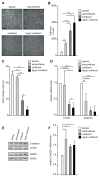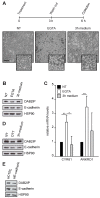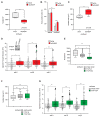The Tumor Suppressor DAB2IP Is Regulated by Cell Contact and Contributes to YAP/TAZ Inhibition in Confluent Cells
- PMID: 37444489
- PMCID: PMC10340159
- DOI: 10.3390/cancers15133379
The Tumor Suppressor DAB2IP Is Regulated by Cell Contact and Contributes to YAP/TAZ Inhibition in Confluent Cells
Abstract
External and internal mechanical forces modulate cell morphology, movement, proliferation and metabolism, and represent crucial inputs for tissue homeostasis. The transcriptional regulators YAP and TAZ are important effectors of mechanical signaling and are frequently activated in solid tumors, correlating with metastasis, chemoresistance, and shorter patient survival. YAP/TAZ activity is controlled by various pathways that sense cell shape, polarity, contacts, and mechanical tension. In tumors, aberrant YAP/TAZ activation may result from cancer-related alterations of such regulatory networks. The tumor suppressor DAB2IP is a Ras-GAP and scaffold protein that negatively modulates multiple oncogenic pathways and is frequently downregulated or inactivated in solid tumors. Here, we provide evidence that DAB2IP expression is sustained by cell confluency. We also find that DAB2IP depletion in confluent cells alters their morphology, reducing cell packing while increasing cell stiffness. Finally, we find that DAB2IP depletion in confluent cells favors YAP/TAZ nuclear localization and transcriptional activity, while its ectopic expression in subconfluent cells increases YAP/TAZ retention in the cytoplasm. Together, these data suggest that DAB2IP may function as a sensor of cell interactions, contributing to dampening cellular responses to oncogenic inputs in confluent cells and that DAB2IP loss-of-function would facilitate YAP/TAZ activation in intact epithelia, accelerating oncogenic transformation.
Keywords: AIP1; Hippo pathway; Ras-GAP; cell stiffness; cell-to-cell contact; contact inhibition; mechanotransduction.
Conflict of interest statement
The authors declare no conflict of interest.
Figures







Similar articles
-
Mechanoregulation of YAP and TAZ in Cellular Homeostasis and Disease Progression.Front Cell Dev Biol. 2021 May 24;9:673599. doi: 10.3389/fcell.2021.673599. eCollection 2021. Front Cell Dev Biol. 2021. PMID: 34109179 Free PMC article. Review.
-
Reciprocal regulation of YAP/TAZ by the Hippo pathway and the Small GTPase pathway.Small GTPases. 2020 Jul;11(4):280-288. doi: 10.1080/21541248.2018.1435986. Epub 2018 Apr 20. Small GTPases. 2020. PMID: 29457552 Free PMC article. Review.
-
A spatial model of YAP/TAZ signaling reveals how stiffness, dimensionality, and shape contribute to emergent outcomes.Proc Natl Acad Sci U S A. 2021 May 18;118(20):e2021571118. doi: 10.1073/pnas.2021571118. Epub 2021 May 14. Proc Natl Acad Sci U S A. 2021. PMID: 33990464 Free PMC article.
-
Mechanical Properties of Glioblastoma: Perspectives for YAP/TAZ Signaling Pathway and Beyond.Diseases. 2023 Jun 14;11(2):86. doi: 10.3390/diseases11020086. Diseases. 2023. PMID: 37366874 Free PMC article. Review.
-
miR-582-5p Is a Tumor Suppressor microRNA Targeting the Hippo-YAP/TAZ Signaling Pathway in Non-Small Cell Lung Cancer.Cancers (Basel). 2021 Feb 11;13(4):756. doi: 10.3390/cancers13040756. Cancers (Basel). 2021. PMID: 33670427 Free PMC article.
Cited by
-
An update on the tumor-suppressive functions of the RasGAP protein DAB2IP with focus on therapeutic implications.Cell Death Differ. 2024 Jul;31(7):844-854. doi: 10.1038/s41418-024-01332-3. Epub 2024 Jun 20. Cell Death Differ. 2024. PMID: 38902547 Free PMC article. Review.
-
The Molecular Basis of Pediatric Brain Tumors: A Review with Clinical Implications.Cancers (Basel). 2025 May 4;17(9):1566. doi: 10.3390/cancers17091566. Cancers (Basel). 2025. PMID: 40361492 Free PMC article. Review.
References
-
- Northey J.J., Przybyla L., Weaver V.M. Tissue Force Programs Cell Fate and Tumor Aggression. Cancer Discov. 2017;7:1224–1237. doi: 10.1158/2159-8290.CD-16-0733. - DOI - PMC - PubMed
Grants and funding
LinkOut - more resources
Full Text Sources
Miscellaneous

